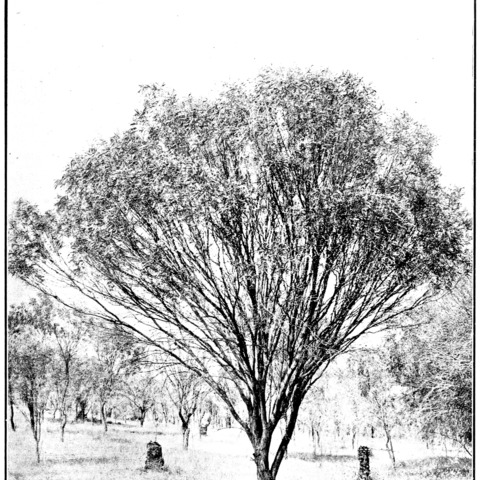Obconic shrub or tree (2–) 3–7 (–10) m high. New shoots with silky, yellow, appressed hairs. Branchlets ascending to erect, infrequently ± pendulous, glabrous. Phyllodes ascending to erect or spreading at various angles, linear to narrowly elliptic, flat, normally straight to shallowly curved, (5–) 8–15 (–18) cm long, (1.5–) 2–8 (–10) mm wide, tapered to a curved-acuminate to caudate, non-pungent, slender apex, bright green, glabrous except fimbriolate in upper c. ½, finely multistriate; midvein often the most prominent. Inflorescences simple, normally 1 or 2 in phyllode axils; spikes sessile, (7–) 10–30 mm long (dry), golden. Flowers mostly 4-merous; calyx dissected by ½ or more, with lobes usually narrow. Pods linear, flat but variably raised over seeds and straight-edged to constricted between them, (2–) 3–8 cm long, 2.5–7 mm wide, firmly chartaceous to thinly coriaceous-crustaceous, brown, clothed with sparse minute caducous hairs. Seeds longitudinal, oblong or elliptic to ovate, 2–4.5 mm long, 1.5–3 mm wide, compressed (1–2.5 mm thick), dark brown to black, shiny to slightly shiny; aril membranous, white or creamy white.
More
An evergreen tree. It grows to 6-12 m high and 4 m across. It normally has a short main stem and then branches spread out giving it a broad crown. The stem is stiff and smooth with grey bark. The timber has the smell of raspberry jam after cutting. The wood is hard and suitable for fencing. The leaves (phyllodes) are bright green and very thin. The are almost round in cross section and 0.25 cm wide. They are 7.5-25 cm long and with a pointed tip. New growth is covered with golden hairs. The flowers are bright yellow. The flowers rods are 13-25 mm long and 6-7 mm wide. They are produced near the ends of branches. The pods are brown, flat and narrow. They can be 5-7.5 cm long and straight. They are 5-8 mm wide. The seeds are dark brown and shiny. They are 3-6 mm long by 2-4 mm wide.
A temperate plant. It prefers light well drained soils. It does best in sunny positions. It can withstand drought and frost. It grows naturally in semi-arid woodlands in Western Australia. It can grow in arid places. It can grow on limestone soils. They can be alkaline. It grows in areas with an annual rainfall between 200-1,100 mm. It grows below 375 m above sea level.
More
Often in gently undulating topography, growing in lateritic gravels or red-brown earths in low semi-arid woodlands and tall shrublands, and in clayey soils on flats and in red sands, often near intermittent streams.
Often in gently undulating topography, on lateritic gravels or red-brown earths in low semi-arid woodlands and tall shrublands, and in clayey soils on flats and in red sands, often near intermittent streams.


